Mixed Wood Forests in the Adirondacks
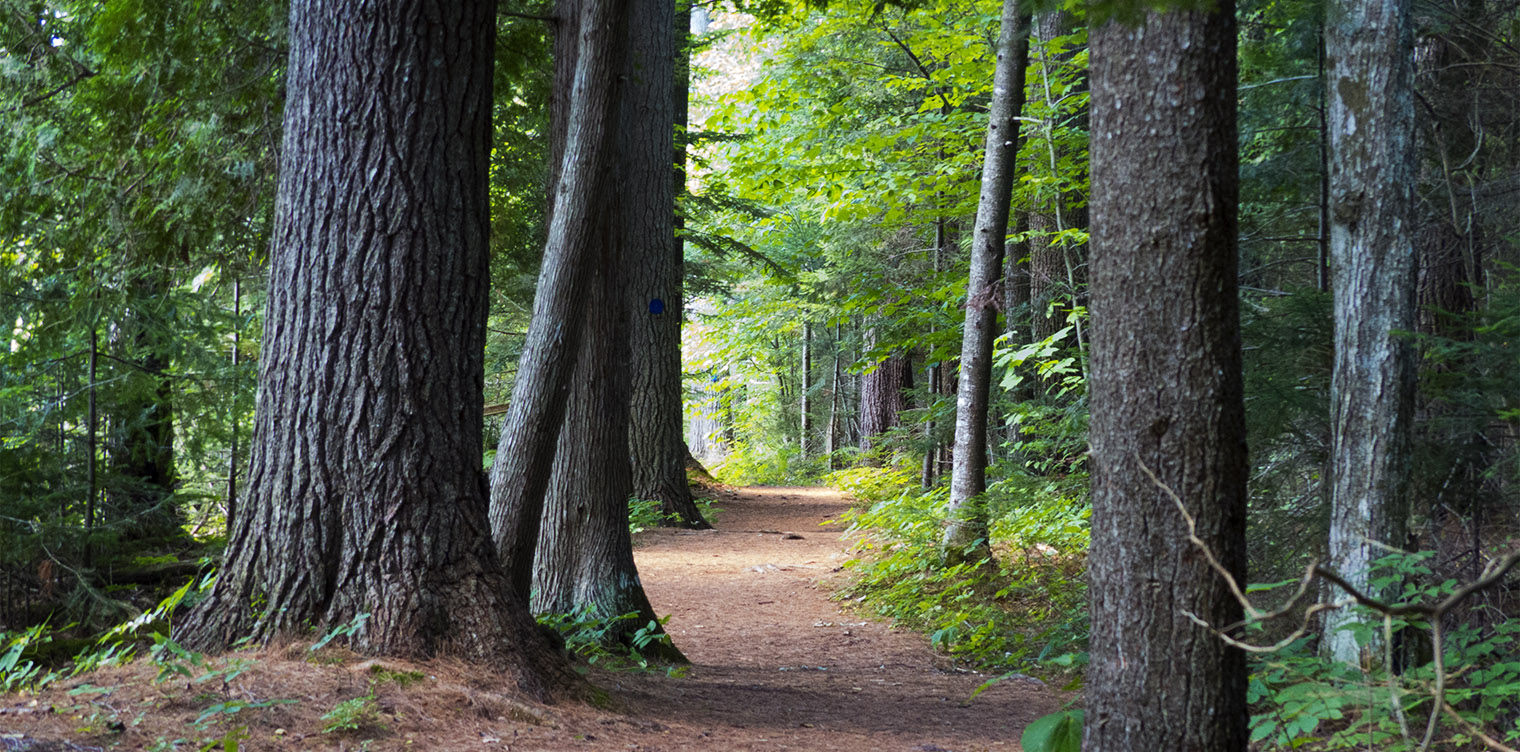
Mixed wood forests represent a transition zone between the forested wetlands on lower elevations and northern hardwood forests, which occupy the better drained, gentle slopes at a slightly higher elevation. In these in-between environments, conifers such as Red Spruce and Balsam Fir mix with Eastern Hemlock, as well as deciduous trees, including Red Maple, Yellow Birch, and other hardwoods.
Mixed Forest Ecological Communities
Mixed wood forest ecological communities in the Adirondacks include:
Mixed wood forests grow on soil derived from outwash – the sand and gravel deposited by glacial rivers. This soil is rarely fertile enough to support the more demanding northern hardwoods. The mix of conifers and hardwoods varies with soil fertility and the height of the water table.
Trees of the Mixed Wood Forest
The dominant species in the Adirondack mixed wood forest include Red Spruce, Balsam Fir, Eastern Hemlock, Red Maple, and Yellow Birch. The percentage of Red Spruce and Balsam Fir is greatest at lower elevations, where a high water table keeps moisture near the surface. Here Red Spruce grows alongside Eastern Hemlock, Red Maple, Black Cherry, and Yellow Birch. The proportion of Red Maple and Yellow Birch increases on better drained areas. Eastern White Pine and Red Pine, species that tolerate droughty conditions, may appear on drier outwash sites like eskers.
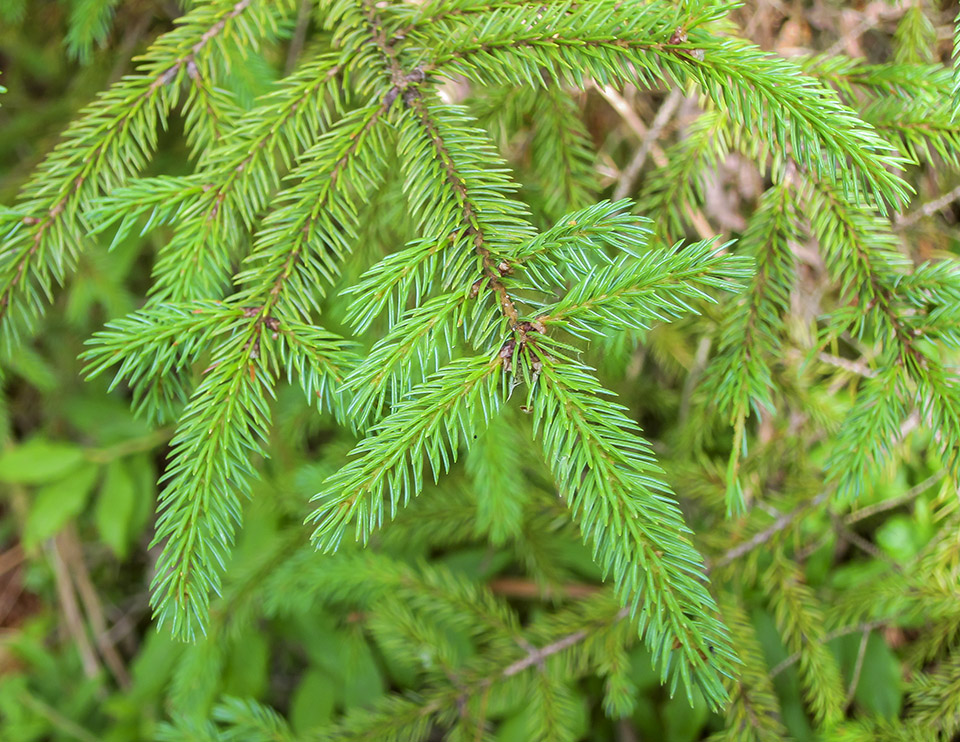
Red Spruce (Picea rubens) is a key component of the mixed wood forest. It is a medium-sized evergreen conifer that grows on glacial deposits. Red Spruce trees can usually be found with Eastern Hemlock and Balsam Fir. Red Spruce trees also grow with deciduous species, including aspens, birches, maples, and beech species.
Red Spruce does not grow in bogs, which is fortunate because this provides a convenient way to distinguish it from Black Spruce.
Red Spruce is quite vulnerable to damage from acid rain, which leaches calcium out of the needles. This reduces the needles' ability to tolerate freezing temperatures and interferes with the tree's ability to acquire nutrients from the thin Adirondack soils.
Red Spruce plays an important role in mixed wood forests, providing food and cover for various mammals and birds. Habitats which include Red Spruce are particularly important as winter cover for White-tailed Deer and, to a certain extent, Moose. Red Squirrels, mice, and voles eat buds and seeds. Porcupines feed on the bark in winter. Red Spruce is a common tree species in the breeding habitat of a wide variety of birds, including White-throated Sparrows and Red-breasted Nuthatches.
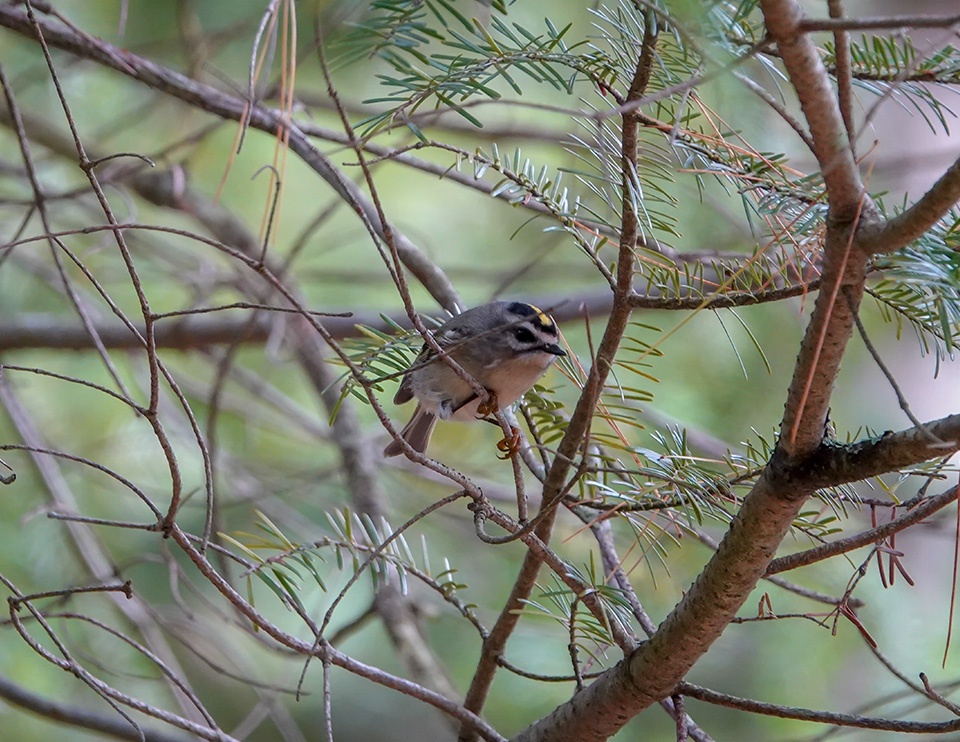
Balsam Fir (Abies balsamea), another conifer, is a common understory tree associated with Red Spruce. Balsam Fir is more aggressive in getting established in the wake of a forest disturbance. However, because it is a short-lived species, it eventually loses out to the more longer-lived Red Spruce. The Balsam Fir features dark green aromatic foliage (tipped by attractive lighter green new growth) and a narrow, pointed, spire-like crown.
The Balsam Fir is moderately important to wildlife.
- The evergreen foliage of young trees is useful to mammals and game birds for cover, especially in winter. Browsers, particularly White-tailed Deer and Moose, may resort to fir foliage as a large part of their winter menu. The seeds are sought by Red Squirrels, Eastern Chipmunks, and other rodents. North American Porcupines feed on the bark.
- Balsam Fir also provides food and breeding habitat for a number of birds. The winged seeds are eaten from the cones by at least eight species of songbirds (such as crossbills). Yellow-rumped Warblers, Magnolia Warblers, Veery, and Rose-breasted Grosbeaks often choose this species as a nest site.
Eastern Hemlock (Tsuga canadensis) is the most shade-tolerant conifer in the East. It can grow in well-drained to poorly-drained till or outwash. It is seen in both northern hardwood forests and mixed wood forests, often near Yellow Birch, Red Spruce, and Balsam Fir.
Eastern Hemlock provides valuable food and winter shelter for wildlife. Many species of wildlife benefit from the excellent habitat that a dense stand of hemlock provides. Hemlock bark and twigs also provide winter nutrition for porcupines, and the seeds provide food for Red Squirrels, mice, voles, and other rodents. Eastern Hemlocks are also important in creating a habitat for birds. This tree is sometimes chosen as a nest site by Yellow-rumped Warblers and Blackburnian Warblers. Other birds rely on the small, winged seeds from the cones for food.
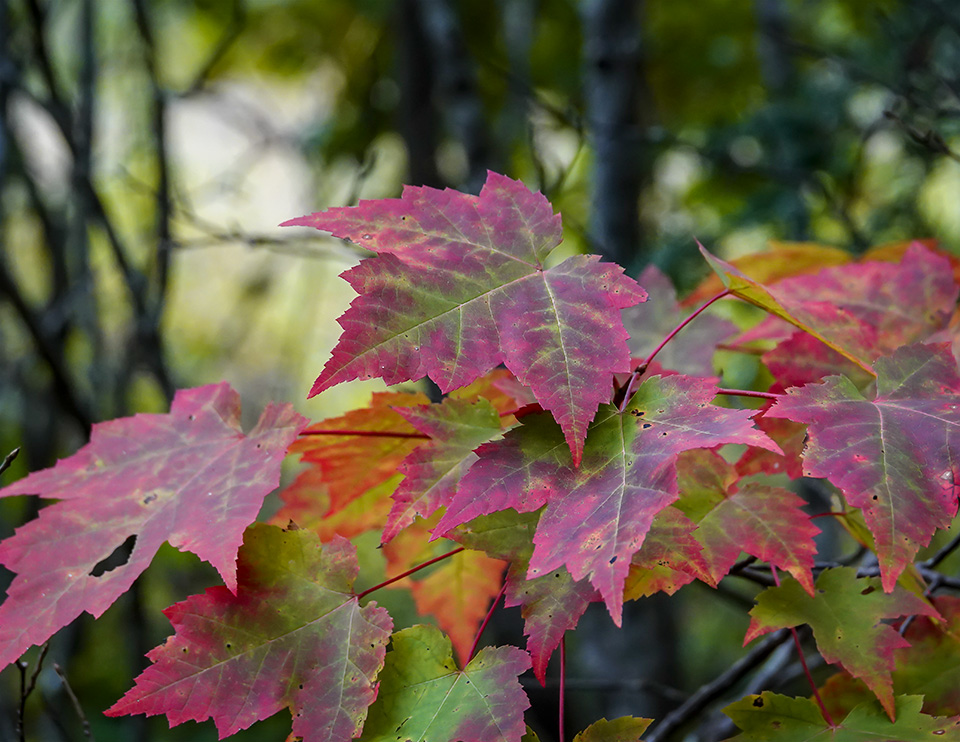
Red Maple (Acer rubrum) is a key deciduous species in mixed wood forests, thriving wherever Sugar Maple cannot dominate. It is not terribly fussy about soil and drainage and does well even in poorly-drained, shallow, or very sandy soils. Moderately shade-tolerant, it will grow almost anywhere except under dense shade. It commonly associates with, and competes with, the Yellow Birch.
The Red Maple is one of the first trees to flower in the spring, generally several weeks before the leaves appear. The flowers are small, with slender stalks, pink to red. This species is one of the early harbingers of autumn, as it turns color well in advance of other eastern deciduous trees, especially when it is located in wet sites. The fiery colors of fall are typically a brilliant red.
Red Maple leaves, twigs, bark, and fruits provide a food source for numerous mammals, birds, and insects. However, Red Maple leaves are extremely toxic to horses and cattle. The species is not preferred by deer as a browse source, so in areas with heavy deer pressure, this species is over-abundant in forest regeneration. The Red Maple is a larval host for the Rosy Maple Moth. Red Squirrels use the cavities of older trees as nesting habitat. A number of birds build nests in Red Maples, including American Redstarts, Black-backed Woodpeckers, and Downy Woodpeckers.
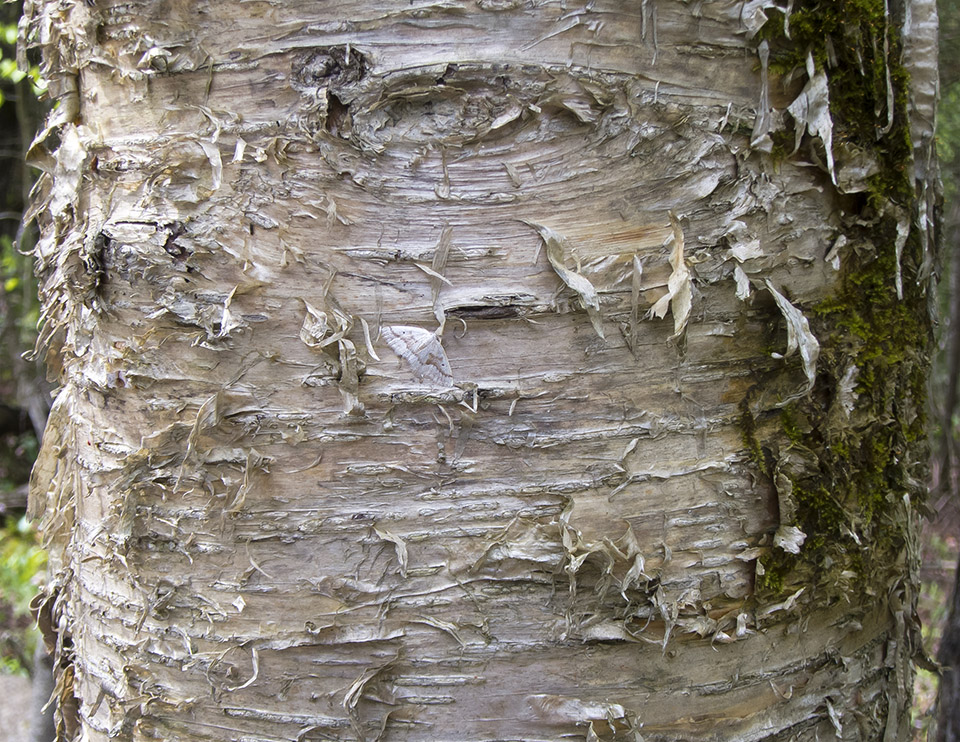
The Yellow Birch is the third dominant tree of the northern hardwoods. It is somewhat less shade-tolerant than Sugar Maple and American Beech, but is able to thrive on more diverse sites, even on hummocks around swamps and other poorly-drained sites where Sugar Maple and American Beech do not occur. The Yellow Birch is common in both mixed wood forests and northern hardwood forests.
Yellow Birch trees are an important plant for wildlife.
- This tree provides a favorite browse for White-tailed Deer. Moose, Eastern Cottontail, and Snowshoe Hare also use the plant for food. Red Squirrels cut and store the mature catkins and eat the seeds. American Beaver and North American Porcupine chew the bark.
- Yellow Birch trees are also an important food source for many birds, including Pileated Woodpeckers, Fox Sparrows, Black-capped Chickadees, Pine Siskin, Common Redpoll, and Ruffed Grouse. This tree also provides a nesting site for Ruby-throated Hummingbirds, Broad-winged Hawks, Red-shouldered Hawks, and Boreal Chickadees.
Shrubs of the Mixed Wood Forest
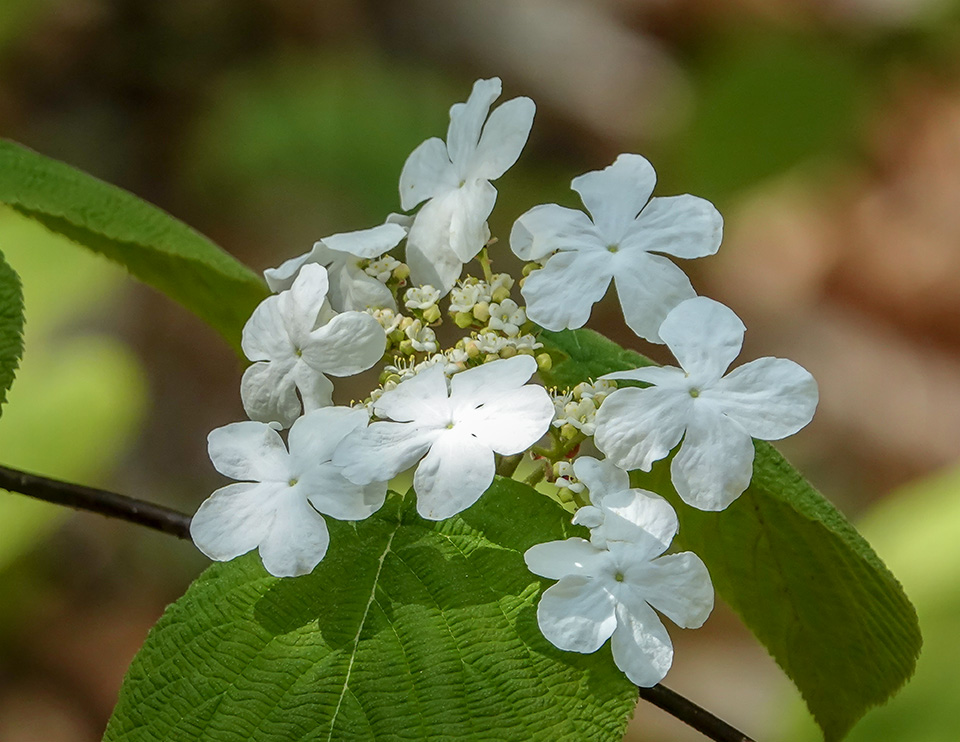
The understory in mixed wood forests consists of shade-tolerant shrubs, smaller tree species, and the saplings of canopy plants. Shrubs associated with the mixed wood forest include Hobblebush, Red Elderberry, Mapleleaf Viburnum, Alternate-leaf Dogwood, American Fly Honeysuckle, and Low Bush Blueberry.
Probably the most abundant understory element seen in this habitat is the ubiquitous Hobblebush, which also occurs commonly in northern hardwood forests. This plant is a native deciduous shrub which can flourish in a variety of habitats, including rich, moist woods, by stream banks, and in swamps. It is abundant in Adirondack forests because it is so shade- and acid-tolerant.
Hobblebush serves a variety of wildlife. The berries are a food source for both game birds and songbirds, such as the Cedar Waxwing, Pine Grosbeak, Brown Thrasher, and Ruffed Grouse. White-tailed Deer and Moose feed on its buds and branches. Hobblebush flowers provide nectar for the Spring Azure butterfly. The shrub's rooting habit improves soil stability on steep terrain and provides cover for many small animals and ground-dwelling birds.
Wildflowers and Ferns of the Mixed Wood Forest
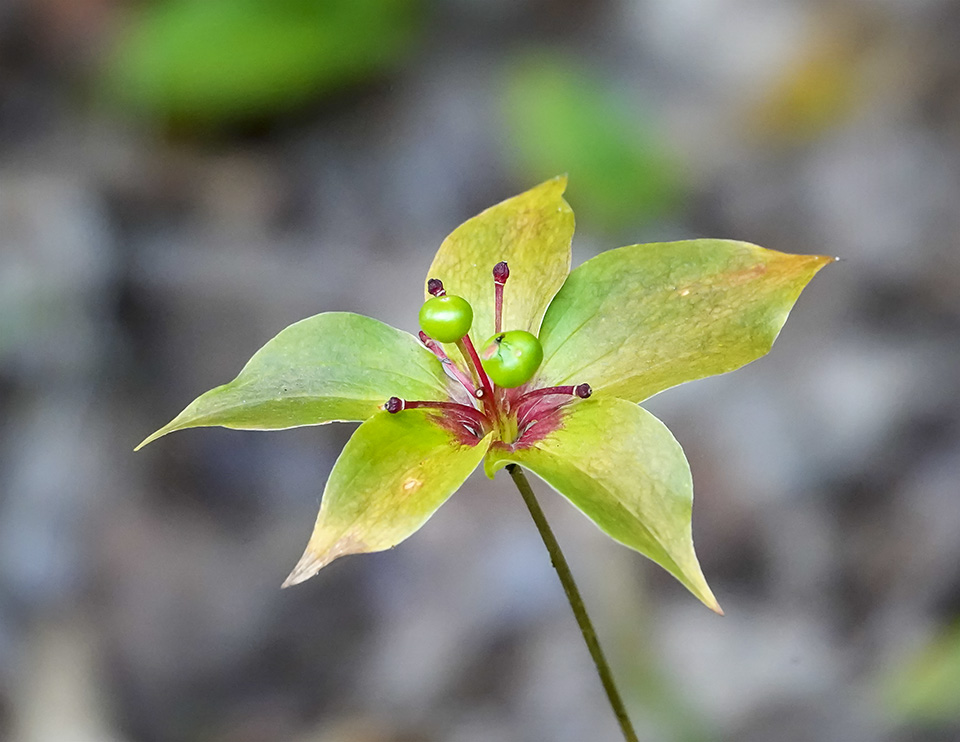
A wide variety of shade-loving wildflowers abounds on the forest floor of a mature mixed wood forest.
- The lengthy list of wildflower species which flourish here includes both spring ephemerals (which grow under deciduous trees and die back after leaf-out) and other spring blooming wildflowers, such as Pink Lady Slipper, Painted Trillium, White Baneberry, Canada Mayflower, Starflower, Jack-in-the-Pulpit, Bunchberry, and Clintonia.
- Summer bloomers that prefer mixed wood forests include Common Wood Sorrel, Pipsissewa, Wintergreen, Indian Cucumber-root, Round-leaved Pyrola, and Twinflower.
- Late summer in the mixed woods forest brings Spotted Touch-Me-Not, Dewdrops, and Whorled Wood Aster. Many of the wildflowers which have bloomed earlier are now decorated with attractive fruit. Examples include the glossy deep blue berries of Clintonia and the bright red berries of Red Baneberry.
As fall and cooler temperatures arrive, most of the shade-loving wildflowers that grow in the mixed wood forest have stopped blooming. To compensate, a number of them add to the fall palette with brilliant foliage or colorful berries.
- Bunchberry foliage turns an eye-catching wine red, with splashes of dark purple.
- The foliage of the two-tiered Indian Cucumber-root turns yellow, with the smaller whorl of three leaves near the top splotched with a bright red center.
- Wild Sarsaparilla foliage turns orange, yellow, or deep red, with accented veins and margins.
- The foliage of White Baneberry turns an attractive yellowish green, with the veins and margins outlined in darker green.
Many of the Ferns and Fern Allies found in northern hardwood forests in the Adirondacks also grow in abundance in mixed wood forests.
- The list includes evergreen ferns such as Spinulose Woodfern (abundant in hardwood and mixed forest), Christmas Fern (which almost always grows under Sugar Maple), and Intermediate Woodfern (which flourishes in hemlock-hardwood forests).
- Deciduous ferns found in the this habitat include Hay-scented Fern (usually growing in large groves in sunny forest openings), Lady Fern (which grows in both northern hardwood and mixed wood forests), and New York Fern (which usually occurs under northern hardwoods).
- Three fern allies – Shining Clubmoss, Bristly Clubmoss, and Tree Clubmoss (also called Princess Pine or Ground Pine) – are also found in this habitat in abundance. Ground Cedar, although less common, can also be found here.
Wildlife of the Mixed Wood Forest
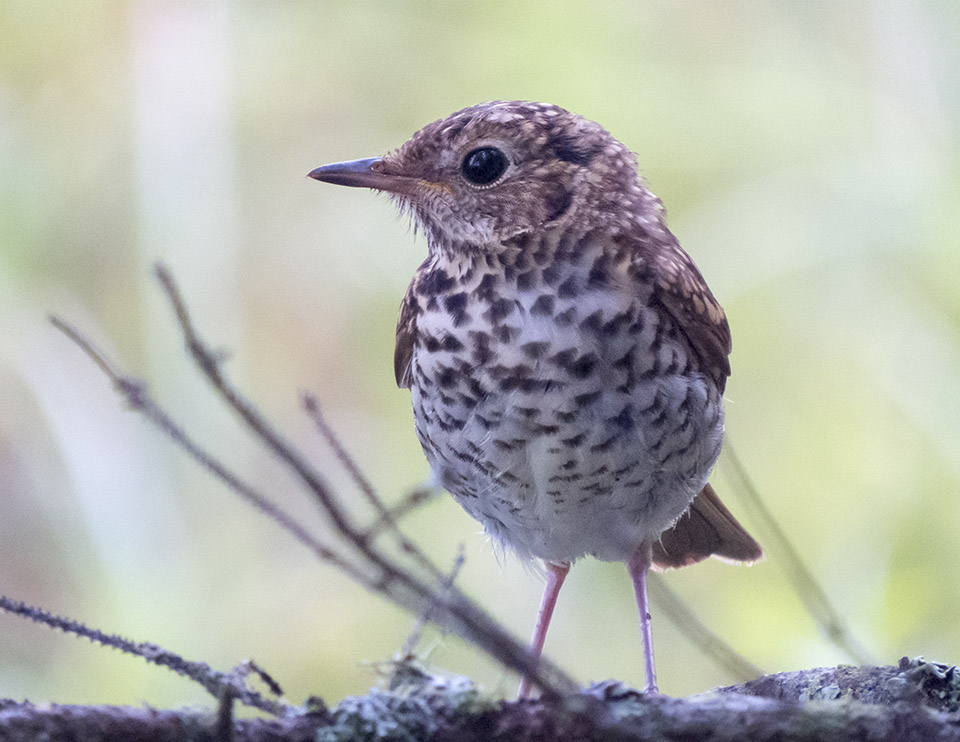
A wide variety of birds are seen and heard in this habitat, including both permanent residents and summer migrants. Many birds which are commonly associated with either hardwood or coniferous forests are equally at home in a mixed wood habitat.
Most of the year-round resident birds that can be found in mixed woodland are species which can flourish in other habitats as well. The list includes the Black-capped Chickadee, Brown Creeper, Common Raven, Golden-crowned Kinglet, Hairy Woodpecker, Pileated Woodpecker, Northern Saw-whet Owl, Purple Finch, Pine Siskin, Red-breasted Nuthatch, Ruffed Grouse, and Blue Jay. For several other birds, like the Barred Owl, the mixed wood habitat is their preferred breeding habitat.
Many of the Adirondack Park's summer birds make their homes in mixed woodlands, wintering further south and returning to the Adirondacks in the spring. Summer residents commonly seen in this habitat include Chipping Sparrows, Hermit Thrush, Red-eyed Vireos, Ruby-crowned Kinglets, Ruby-throated Hummingbirds, White-throated Sparrows, and Winter Wrens.
Mixed woodlands also provide a major breeding habitat for a wide variety of warblers, like the Black-throated Blue Warbler, Black-throated Green Warbler, Blackburnian Warbler, Canada Warbler, Nashville Warbler, Northern Parula, Ovenbird, Pine Warbler, and Yellow-rumped Warbler.
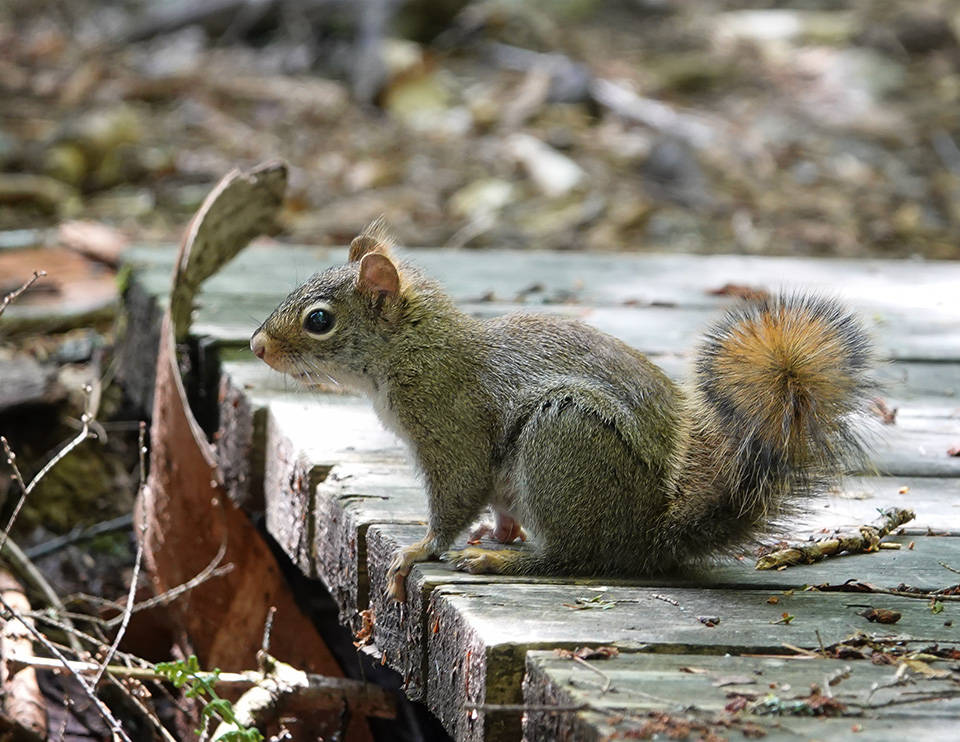
Mammals that live in mixed wood forests in the Adirondacks include the Eastern Coyote, Red Fox, Bobcat, Fisher, Long-tailed Weasel, American Marten, Ermine, Raccoon, Black Bear, Eastern Chipmunk, Gray Squirrel, Red Squirrel, Northern Flying Squirrel, Southern Flying Squirrel, Snowshoe Hare, and White-tailed Deer. Many of these mammals can also be found in other habitats.
These species rely to varying degrees for food and shelter on both deciduous and coniferous trees, or the wildlife that dwells near them. Many of these mammals (such as the Black Bear, Red Fox, and Raccoon) are omnivores, consuming a wide variety of food items. Others, like the Bobcat, Long-tailed Weasel, and Ermine, are carnivores. White-tailed Deer and North American Porcupines are herbivores.
The distribution of each species is linked in part to the availability of its major food source. The Eastern Coyote, for instance, occupies virtually any habitat, but seems to prefer areas with a combination of brushy areas, woodlots, and open country. Although coyotes are opportunistic carnivores, consuming many species of small mammals, White-tailed Deer make up an important winter food source for coyotes living in the Adirondacks. For that reason, coyotes (which reportedly hunt deer in small packs, like wolves) appear to be more abundant in places where deer are common, such as the lower elevation areas of the Adirondack Park.
Some species of butterflies and moths can be found near mixed wood forests in the Adirondack Mountains.
- Butterflies seen in this habitat include the Aphrodite Fritillary, Cabbage White, Canadian Tiger Swallowtail, Great Spangled Fritillary, Hobomok Skipper, Painted Lady, Pink-edged Sulphur, Question Mark, Red Admiral, and White Admiral.
- Moths which live here include Hummingbird Clearwing and Virginia Ctenucha.
Look for these insects along the edges or trails or in forest clearings, since many of them use the sun-loving wildflowers that grow in these spaces as host plants or as sources of nectar as adults.
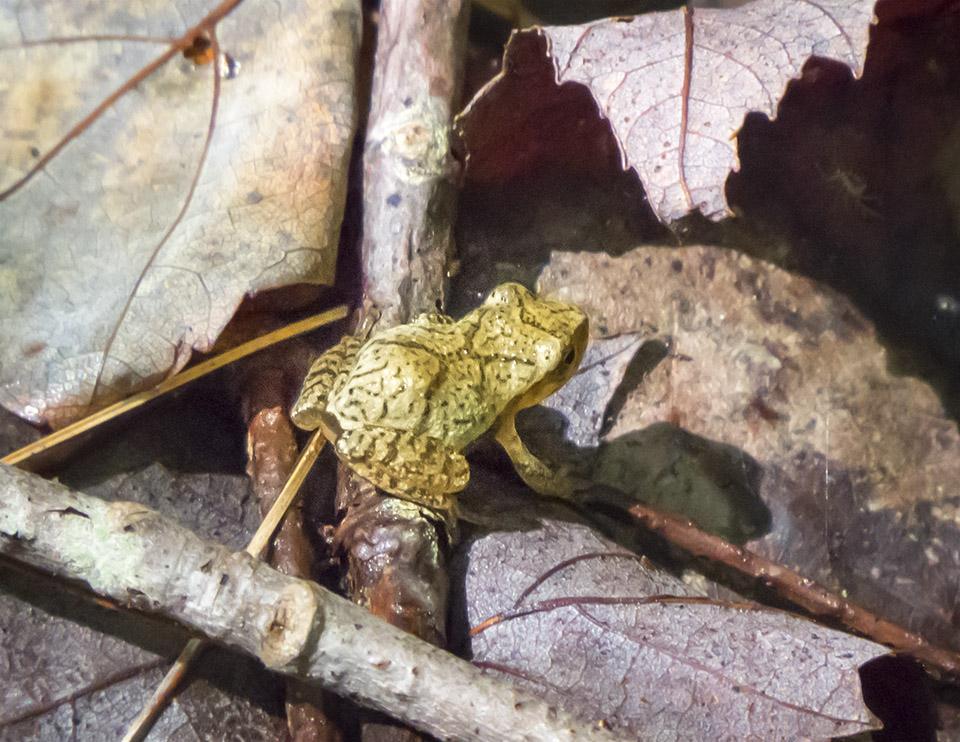
Amphibians and Reptiles that dwell in mixed woodlands include the Mountain Dusky Salamander, Red-backed Salamander, Red-backed Salamander, Eastern Newt, American Toad, Spring Peeper, Gray Tree Frog, Wood Frog, Ringneck Snake, Red-bellied Snake, and Common Garter Snake. Some are generalists, like the Common Garter Snake and American Toad, and are found in many terrestrial habitats.
The Spring Peeper (Pseudacris crucifer) is well-known for its shrill peeping sounds which herald spring. Only about an inch in length when full grown, the Spring Peeper sports a characteristic "X" on its back. Spring Peepers spend the winter in a dormant state under layers of debris on the forest floor. As the ground warms in the spring, they trek off to pond edges and marshes, where the males begin advertising their availability for breeding with a chorus of shrill, melodious (and sometimes deafening) peeps. After the spring breeding season, the tiny amphibian travels back into the nearby woods, where some sporadic peeping may be heard in fall, usually during a period of mild temperatures.
Another amphibian found in wooded areas of the Adirondack Park is the Gray Tree Frog (Dryophytes versicolor)), a small arboreal frog native to much of the eastern United States and southeastern Canada. The Gray Tree Frog is not often seen, because it spends much of its time residing on branches and twigs above eye level, rather than on the forest floor. Moreover, this creature is equipped with a very effective protective camouflage. Normally gray or grayish green, the Gray Tree Frog can vary its color, depending on its background – a strategy that makes it so inconspicuous that it is likely to be overlooked by passing trail walkers. The Gray Tree Frog navigates through the branches using toes equipped with special suction-cup ends that allow it to attach itself to tree surfaces.
References
James M. Ryan. Adirondack Wildlife: A Field Guide (University of New Hampshire Press, 2008), pp. 13-42.
D. Andrew Saunders. Adirondack Mammals (Adirondack Wildlife Program. State University of New York College of Environmental Sciences and Forestry, 1995).
William K. Chapman. Mammals of the Adirondacks: A Field Guide (Utica, New York: North Country Books, 1991).
William K. Chapman and Alan E. Bessette. Trees and Shrubs of the Adirondacks: A Field Guide (Utica, New York: North Country Books, 1990).
Alan E. Bessette et al. Birds of the Adirondacks: A Field Guide (Utica, New York: North Country Books, 1993).
Boughton Cobb et al. A Field Guide to Ferns and Their Related Families: Northeastern and Central North America (Houghton Mifflin Company, 2005).
E. H. Ketchledge. Forests and Trees of the Adirondack High Peaks Region (Adirondack Mountain Club, 1967), pp. 18-43, 96-101, 107-108, 129-131.
Michael Kudish. Adirondack Upland Flora: An Ecological Perspective (Saranac, New York: The Chauncy Press, 1992).
John Kricher. A Field Guide to Eastern Forests. North America (Boston: Houghton Mifflin, 1998), pp. 154-219.
Peter J. Marchand. Nature Guide to the Northern Forest. Exploring the Ecology of the Forests of New York, New Hampshire, Vermont, and Maine (Appalachian Mountain Club, 2010), pp. 13-18, 56-93.
Donald J. Leopold and Lytton John Musselman. Wildflowers of the Adirondacks (Johns Hopkins University Press, 2020), pp. 31-36.
Roger Conant and Joseph T. Collins. Reptiles and Amphibians. Eastern/Central North America (Houghton Mifflin Company, 1975).
Mark J. Twery et al. Changes in Abundance of Vascular Plants under Varying Silvicultural Systems at the Forest Ecosystem Research and Demonstration Area, Paul Smiths, New York. United State Department of Agriculture. Forest Service. Northern Research Station. Research Note NRS-169. 25 July 2012. Retrieved 18 January 2017.
Adirondack Park Agency. Preliminary List of Species Native Within the Adirondack Park Listed Alphabetically by Scientific Name and Sorted by Habit. Volume 1. 23 October 2006. Retrieved 18 January 2017.
New York State Department of Environmental Conservation. New York Natural Heritage Program. Ecological Communities of New York State. Second Edition (March 2014). Retrieved 17 January 2017.
New York Natural Heritage Program. 2022. Online Conservation Guide for Hemlock-Northern Hardwood Forest. Retrieved 29 March 2022.
New York Natural Heritage Program. 2022. Online Conservation Guide for Pine-Northern Hardwood Forest. Retrieved 29 March 2022.
New York Natural Heritage Program. 2022. Online Conservation Guide for Spruce Flats. Retrieved 29 March 2022.
New York Natural Heritage Program. 2022. Online Conservation Guide for Spruce-Northern Hardwood Forest. Retrieved 29 March 2022.
Adirondack Park Agency. Natural Communities of the Adirondack Park. Retrieved 13 January 2017.
Cornell Lab of Ornithology. All About Birds. Retrieved 17 January 2017.
Birds of North America. Subscription web site. Retrieved 20 January 2017.
Butterflies and Moths of North America. Retrieved 17 January 2017.
Adirondack Ecological Center. Adirondack Birds. Retrieved 20 January 2017.
University of Michigan. Animal Diversity Web. Retrieved 22 January 2017.
Tom Kalinowski, "Adirondack Salamanders: The Red-Spotted Newt," Adirondack Almanack, 29 September 2014 Retrieved 17 January 2017.
Tom Kalinowski, "Adirondack Amphibians: Spring Peepers," Adirondack Almanack, 15 April 2013. Retrieved 31 January 2019.
Paul Hetzler, " Spring Music: Peepers, Wood Frogs, And Chorus Frogs," Adirondack Almanack, 6 April 2016. Retrieved 31 January 2019.
Tom Kalinowski, "Adirondack Amphibians: Spring Peepers in Autumn," Adirondack Almanack, 8 October 2012. Retrieved 31 January 2019.
Michael J. Caduto, "Adirondack Wildlife: Fall Peepers?" Adirondack Almanack, 28 September 2016. Retrieved 31 January 2019.
Tom Kalinowski, "Late Spring and the Gray Tree Frog," Adirondack Almanack, 28 May 2012. Retrieved 31 January 2019.
